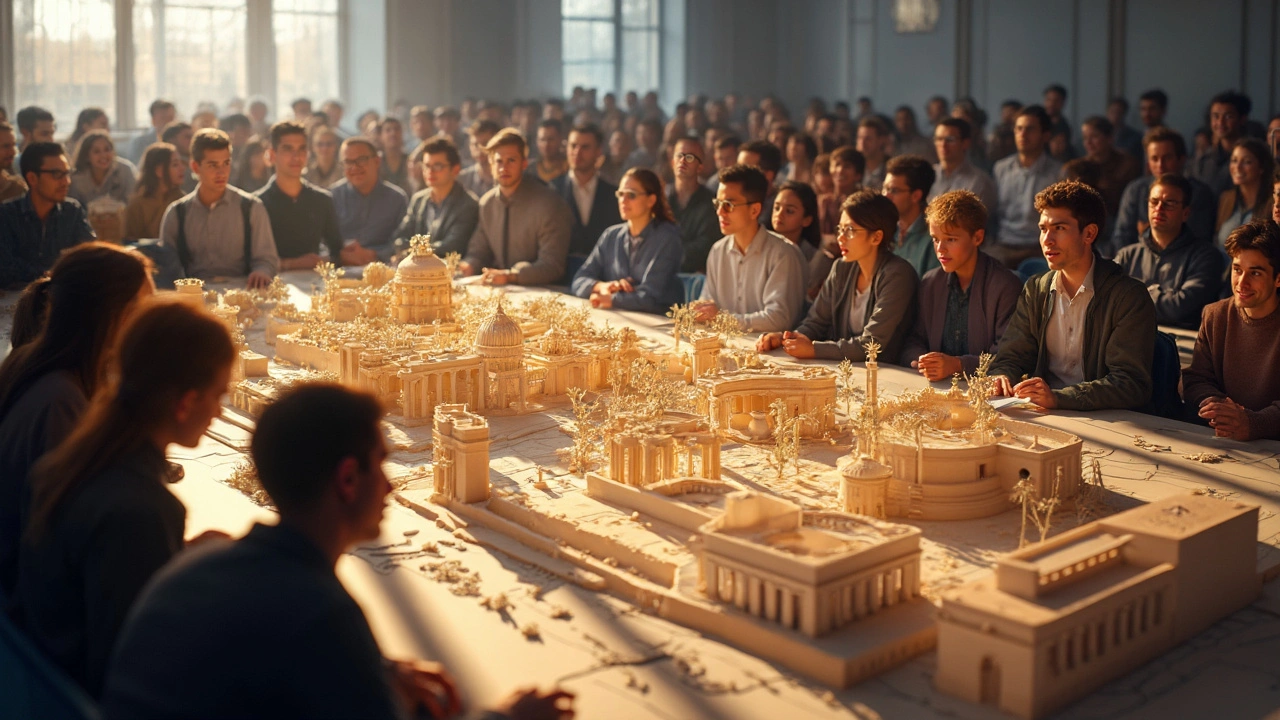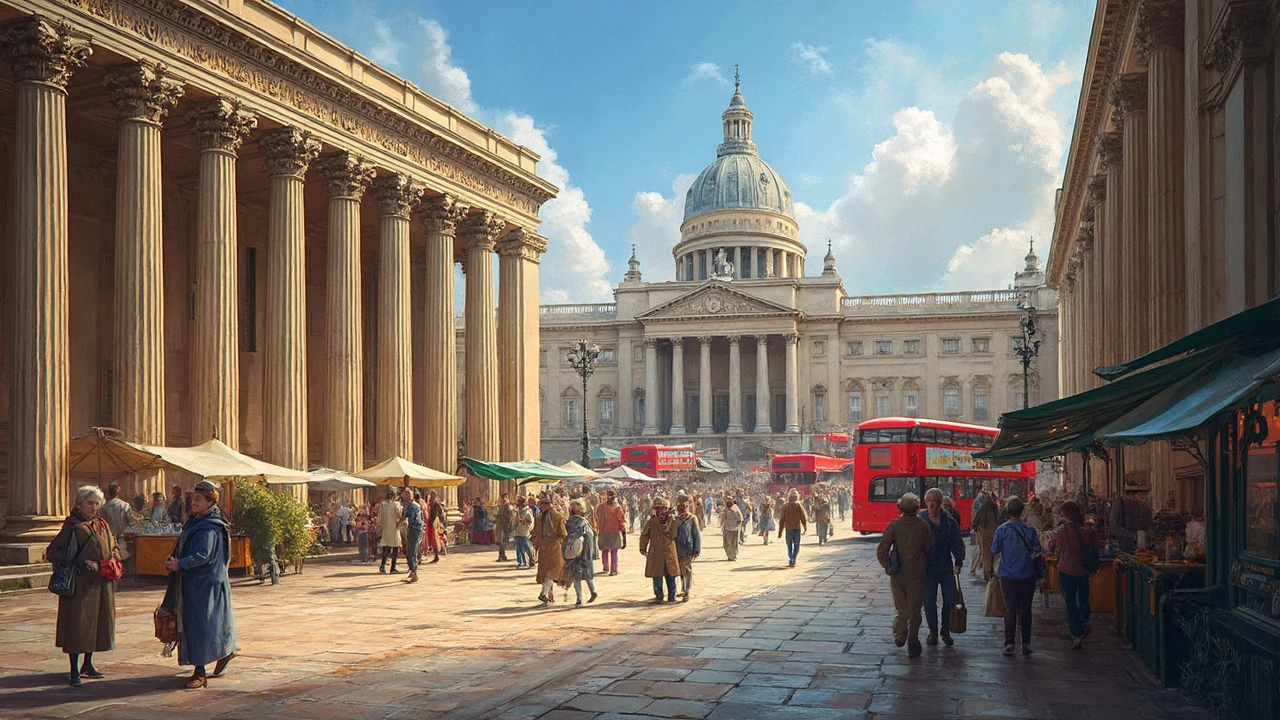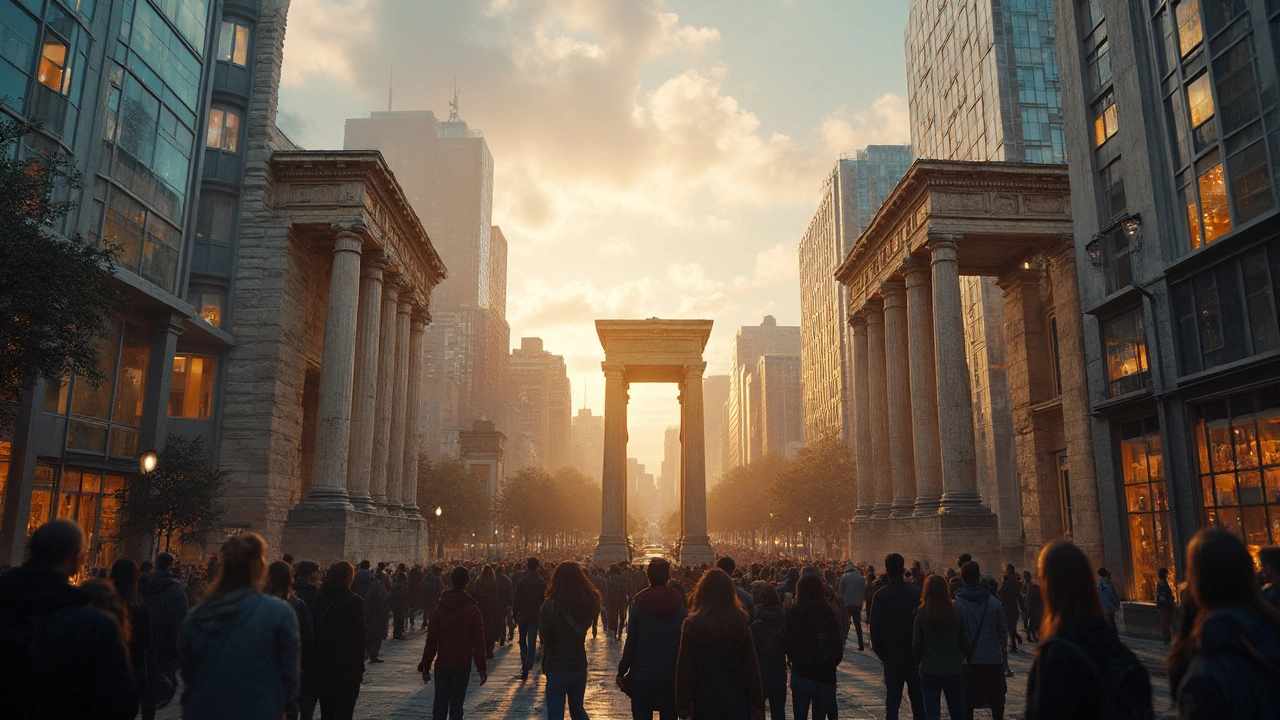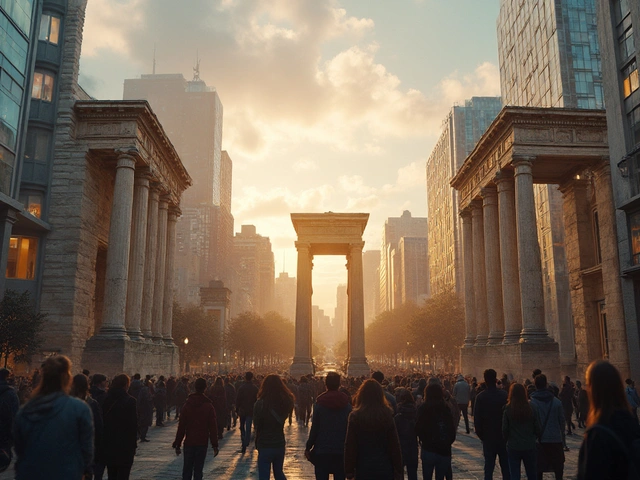You ever walk into a grand, echoing building—high ceilings above you, arches sweeping everywhere, and suddenly spot those iconic Roman columns? It hits you: Romans weren’t just good at stadiums and aqueducts—they pretty much created the blueprint for half the buildings we still swoon over. Ancient Roman architecture doesn’t just sit in history books; it’s standing right in our cities, stitched into everyday life, even if we don’t always notice.
The Roots of Roman Brilliance: Origins and Inspirations
So, where did the genius for ancient Roman architecture come from? The Romans definitely didn’t start from scratch. They borrowed a lot—let’s be real—from the Greeks, Etruscans, and even Egyptians. But Romans weren’t just copycats. Take arches, for instance. Sure, Etruscans spotted them first, but Romans grabbed the idea and built entire cities with it. They made the arch not only a decorative touch but also the backbone of gigantic structures, some so solid they're still standing almost 2000 years after the last toga party.
Columns are another giveaway of their magpie brilliance—mixing and matching Greek styles like Doric, Ionic, and Corinthian. They gave us the Composite order, basically saying, “Why settle for one when we can have it all?” Romans loved putting their own stamp on things. They tied in the engineering knowhow of conquered people (cheeky but clever) and improved on everyone else's mistakes. For instance, concrete, which the Greeks messed around with but dropped, became a Roman favorite. The tricky bit is, their special recipe—opus caementicium—used volcanic ash and lime, making it unbelievably tough and even able to set underwater. Builders today still study Roman concrete formulas, scratching their heads at how some ancient harbors haven’t crumbled despite centuries of battering waves.
What’s wild is how practical their inspirations were. They built for a growing empire: forums for trading and legal squabbles, basilicas for business or law, and temples meant for the gods but also making a strong “Look what we’ve got” statement. These weren’t just vanity projects; they were solutions for the hustle and bustle of city life, from Rome to the edge of their empire. Some say their buildings showed off the empire’s power better than any army could parade down a street.
Structural Innovations: How Romans Changed the Game
You wanna talk about showing off? The Romans took utility and turned it into spectacle. They cracked the mystery of huge domed spaces—something their neighbors couldn’t pull off. Look at the Pantheon. That domed roof? Still holding the “biggest unreinforced concrete dome in the world” title, two millennia later. The open oculus at its top pulls in light and rain, a daring move that keeps architects marveling. The clever part: the dome gets lighter as it goes up, and even the concrete recipe changes layer by layer. Genius and practical, too.
Their aqueducts are another flex. Rome had up to eleven of these water highways, supplying over a million city dwellers with fresh water each day. These marvels could stretch for miles, crossing valleys on stacked arches. Some scholars say Rome had around 500 miles of aqueducts—no small feat when you’re relying on gravity alone and rocks you hand-chiseled from the land. Their public baths, like the Baths of Caracalla, boasted heated floors (hypocausts) and towering spaces designed for relaxation, gossip, and business—all in one sweaty, marble-lined package.
Let’s talk roads. “All roads lead to Rome” isn’t an exaggeration—they built up to 250,000 miles of roads throughout their empire. The crazy part? Some of those roads, thanks to stone, gravel, and concrete layers, are still walkable or drivable. You can thank the Romans every time you curse traffic or roll over a pothole—the model of connected cities they dreamed up is still in play today.
If you love stats and specifics (who doesn’t?), check out this handy table:
| Structure | Roman Name | Year Built | Fun Fact |
|---|---|---|---|
| Pantheon | Pantheon | 118-128 AD | Largest unreinforced concrete dome still in existence |
| Colosseum | Amphitheatrum Flavium | 72-80 AD | Held 50,000–80,000 cheering spectators |
| Aqueduct of Segovia | Pontem Segoviam | 50 AD | Stands over 28m tall—no mortar holding the stones |
| Roman Roads | Viae | 500 BC onward | Network stretched more than 250,000 miles at its peak |
| Basilica of Maxentius | Basilica Nova | 307-312 AD | Largest building in the Roman Forum, innovative use of concrete vaults |
Everything was calculated. They had rules for proportions, even wrote instruction manuals (hi, Vitruvius) so future builders could keep the magic going. The scale of their ambitions wasn’t just to flex muscle; it was about creating reliable, reusable blueprints for empire-sized growth.

Cultural Impact: Buildings as Propaganda and Everyday Life
The power of Rome wasn’t just on the battlefield—it was literally built into the streets. Each monument, every arch and column, was a mashup of pride and purposeful messaging. Take triumphal arches—huge, ornate gates to commemorate military success. They weren’t just vanity projects for emperors; these structures shouted, “Rome is unbeatable” to every visitor and local passing by, turning architecture into a kind of ancient social media feed.
The scale of public buildings broadcasted the empire’s priorities. Colosseums, like the one in Rome, held up to 80,000 shouting fans—almost the size of a modern football stadium. These places turned state-funded entertainment into community glue, but also a handy distraction from any social grumbling. Theaters, forums, temples—they were all part of a system. You didn’t just worship or shop. You interacted—debated, cheered, gossiped—inside these beautiful, imposing spaces.
What about the regular folk? Think about apartment blocks (insulae) that stacked up urbanites in the world’s first big cities. Sure, they weren’t always fancy, but they were the prototype for today’s flats and condos. Meanwhile, rich Romans built country villas with columns, courtyards, and open-air pools, setting aspirational standards people still chase.
Temple design is another place Romans mixed function and symbolism. Beyond worship, temples aligned with key city points, influenced market locations, and played host to communal events. They linked the city’s spirit to its stone and concrete—a permanent “We’re here to stay” message. Even a wedding, festival, or legal trial might unfold in these iconic spaces, blending civic life with architectural gravitas.
It’s hard to overstate this. When an emperor wanted to make a splash or remind people who was in charge, he didn’t just give a speech—he built something so jaw-dropping that people whispered about it for centuries. These structures set the scene for daily life, politics, and cultural memory, shaping not just how cities looked but how they felt to live in.
Roman Legacy: Their Lasting Influence on Modern Design and Engineering
Pop into any state capitol, courthouse, or even some suburban homes and you’ll spot clues—arched windows, dome ceilings, columns, and geometric balance—that Romans still have a hand in the blueprints. It’s wild just how much Western architecture owes them. They shaped not just the look but the logic of construction. Even the way we zone modern cities—public squares, government hubs, marketplaces—has Roman DNA all over it.
Gothic cathedrals and Renaissance palaces? Direct lines to Roman ideas. Notre Dame’s ribbed vaults and Giorgio Vasari’s use of domes and concrete all tip their hats to Roman mastery. When engineers in the 19th century rolled out steel and glass, their models were often Victorian visions of ancient Rome—no one could resist the grandeur of columns and sweeping arches. The U.S. Capitol building wouldn’t look the way it does if not for the Roman Capitolium temple.
The rules of proportion and symmetry that Vitruvius outlined are still taught to students today. Want to design a durable bridge, plaza, or stadium? First, see how Romans did it. Even the most jaw-dropping modern sports arenas owe their tiered seating and oval shapes to the old Colosseum in Rome.
Museums, luxury hotels, banks, and even school buildings keep recycling the classics, not just because they’re beautiful. Roman design solves practical problems—supporting vast roofs, handling foot traffic, channeling crowds—better than you’d guess from their age. And science is still catching up: recent chemistry studies suggest Roman concrete actually becomes stronger over time, unlike ours, which usually cracks and crumbles.
By the way, if you want your own place to feel a little Roman, try adding a small arch to an entryway, pick up a sleek Doric column-style lamp, or even lay a mosaic tile on your kitchen splashback. The Romans were about both luxury and “let’s solve problems,” a design ethos that’s surprisingly timeless.

Tips for Experiencing and Studying Roman Architecture Today
If this ancient world sounds like something straight outta the movies, but you want to see for yourself, good news: Roman masterpieces are hiding in plain sight on almost every continent. The best way to experience Roman design? Plan a trip to places where the real thing still stands proud—or snoop around your city for Roman-inspired landmarks you might have overlooked.
Rome is obviously the motherlode. The Pantheon hits you with the sheer “how did they build this?!” factor. The Colosseum is a reminder that stadium hype isn’t new. But there’s more: the ancient port of Ostia, Hadrian’s Villa in Tivoli, and the triumphal arches scattered around Europe give you goosebumps even now.
If Europe’s a stretch, museums like The British Museum in London or The Metropolitan Museum of Art in New York display real Roman columns, mosaics, and architectural fragments. Interactive 3D virtual tours online mean you don’t need a plane ticket to marvel at domes or walk along ancient roads.
- Bring binoculars for closer looks at intricate carvings (temple pediments can have wild stories hiding in the stone).
- Read up about your city’s buildings—many early American banks, train stations, and government buildings are Roman knock-offs in disguise.
- Download an augmented reality app; some let you layer ancient monuments onto today’s street scenes, which is wild for history lovers.
- If you design or build, dive into Roman construction ratios—they can help with everything from garden pergolas to modern greenhouses.
- And here’s a tip from my own household (thanks, Bradley): When planning our last kitchen renovation, we borrowed Roman mosaic designs for a splash of “ancient chic” over the sink. Suddenly, rinsing vegetables felt historic.
One last quirky fact: The Romans invented the apartment block, and their model solves a puzzle of modern urban living. They mixed shops at street level, apartments above, and even packed in social spaces—making “mixed-use developments” kind of a two-thousand-year-old trend.
So next time you sit in a city square or pass under an arched hallway, remember: you’re not just looking at a pretty structure. You’re standing inside the story of how ancient Rome built the modern world by blending genius engineering, day-to-day practicality, and an eye for what lasts forever.




